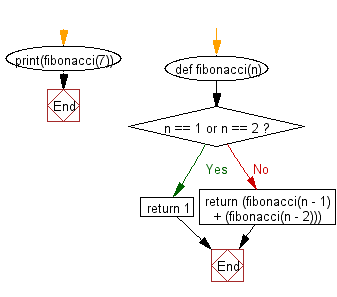Python Data Structures and Algorithms - Recursion: Fibonacci sequence
5. Fibonacci Sequence Using Recursion
Write a Python program to solve the Fibonacci sequence using recursion using recursion.
Sample Solution:
Python Code:
# Define a function named fibonacci that calculates the nth Fibonacci number
def fibonacci(n):
# Check if n is 1 or 2 (base cases for Fibonacci)
if n == 1 or n == 2:
# If n is 1 or 2, return 1 (Fibonacci sequence starts with 1, 1)
return 1
else:
# If n is greater than 2, recursively call the fibonacci function
# to calculate the sum of the (n-1)th and (n-2)th Fibonacci numbers
return fibonacci(n - 1) + fibonacci(n - 2)
# Print the result of calling the fibonacci function with the input value 7
print(fibonacci(7))
Sample Output:
13
Flowchart:

For more Practice: Solve these Related Problems:
- Write a Python program to generate the nth Fibonacci number using a naive recursive method.
- Write a Python program to generate a list of Fibonacci numbers up to n terms recursively.
- Write a Python program to implement a recursive Fibonacci function with memoization to optimize performance.
- Write a Python program to recursively compute the Fibonacci sequence and print each term as it is generated.
Go to:
Previous: Write a Python program to get the factorial of a non-negative integer.
Next: Write a Python program to get the sum of a non-negative integer.
Python Code Editor:
Contribute your code and comments through Disqus.
What is the difficulty level of this exercise?
Test your Programming skills with w3resource's quiz.
